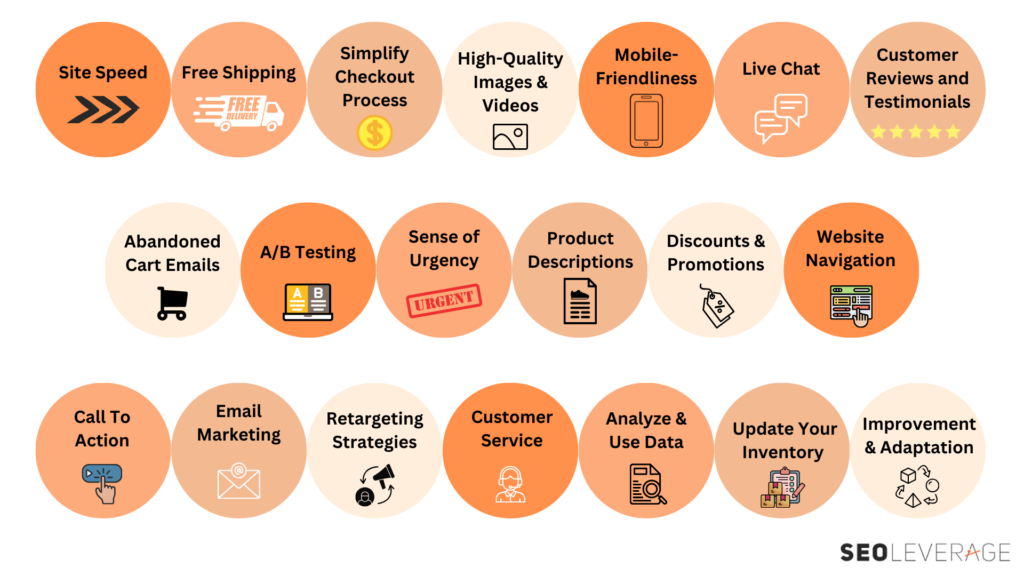To grow and succeed in ecommerce, it is crucial to learn and understand how to improve conversion rates. Having a good plan will boost sales and enhance the customer experience.
Table of Contents
What is an Ecommerce Conversion Rate?
An ecommerce conversion rate is an important number that shows how many people visit your online store to do something you want them to do. This could be buying something, signing up for your newsletter, or putting items in their shopping cart. It tells you how good your online store is at making visitors into customers.
If you have a good conversion rate, it means your website is doing a great job. It's got great product pages and makes shopping easy and enjoyable for the people you want to attract.
What is a Good Ecommerce Conversion Rate?
A good e-commerce conversion rate is a benchmark for evaluating the success of an e-commerce website. On average, an e-commerce conversion rate should be between 1% to 4%. Many factors can impact the conversion rate of your online store. These factors include the industry you are in, the products you sell, their prices, and your target audience.
For example, online stores that sell expensive luxury items may have lower sales due to their high prices. Stores selling everyday, necessary items might see more sales. E-commerce stores need to look at their own sales numbers and compare them to others in their market. Tools like Google Analytics are helpful for this. They let you see how well you're doing compared to the average in your industry.
How to Improve Ecommerce Conversion Rates
Here are 20 strategies to help you improve your ecommerce store's performance.
1. Optimize Site Speed
Site speed is a crucial factor in retaining potential customers on your ecommerce site. A slow-loading page can increase bounce rates, as online shoppers often lack the patience for delays. Improving site speed is a key aspect of conversion rate optimization. Utilizing tools like Google Analytics to track site performance and identify areas for improvement is essential. Faster loading times enhance user experience and may impact your ecommerce conversion rate.
2. Offer Free Shipping
Offering free shipping is a powerful strategy to improve ecommerce conversion rates. It addresses a common barrier to sales - shipping costs. Online stores that give free shipping usually get more sales and keep customers coming back for more. This helps increase their sales rate. If it's hard to cover the cost of free shipping, they could offer it only for orders that cost more than a certain amount. This way, they can manage the shipping costs better.
3. Simplify the Checkout Process
A complex checkout process can hinder conversions. Streamlining the checkout page to reduce the number of steps and offering multiple payment methods can enhance the customer experience. Ensuring a smooth checkout process with minimal unexpected costs is crucial for ecommerce businesses looking to increase conversions. An easy checkout process is a key component of conversion rate optimization, leading to more sales and satisfied customers.
4. Use High-Quality Images and Videos
High-quality images and videos are crucial for product pages on an ecommerce website. They provide a clear and detailed view of the products, compensating for the lack of physical interaction. Utilizing high-quality visuals is an effective way to boost your ecommerce conversion rate, as they help potential customers make informed decisions, thereby increasing the likelihood of purchase.
5. Ensure Mobile-Friendliness
With a significant portion of ecommerce sales coming from mobile devices, ensuring that your online store is optimized for mobile is imperative. A mobile-friendly ecommerce site should offer seamless navigation, quick load times, and a responsive design. This aligns with the growing number of mobile users, which can positively impact your ecommerce conversion rates.
6. Implement Live Chat
Adding live chat to your ecommerce site can improve customer experience and increase sales. It offers instant help by addressing questions and issues in real-time, and helps guide potential customers as they make their purchasing decisions. This direct interaction can effectively boost sales and foster customer loyalty.
7. Display Customer Reviews and Testimonials
Customer reviews and testimonials provide social proof, and a powerful influence on potential customers' buying decisions. Displaying positive reviews on ecommerce websites builds trust and credibility as it encourages new customers to make purchases. This strategy is vital for boosting ecommerce conversion rates and establishing a loyal customer base.
8. Send Abandoned Cart Emails
Abandoned cart emails are another good way to re-engage those customers who have left items in their carts. These emails can remind customers of their initial interest and incentivize them to complete their purchase, especially when combined with offers like discounts or coupon codes. This strategy is crucial for ecommerce businesses looking to recover lost sales.
9. Conduct A/B Testing
This is essential for identifying the most effective elements of your ecommerce website. You can pinpoint what resonates best with your target audience by testing different versions of web pages, layouts, color schemes, or call-to-action buttons. Regular A/B testing is a key practice in conversion rate optimization, leading to continuous improvements in your ecommerce conversion rates.
10. Create a Sense of Urgency
Building a sense of urgency through limited-time offers or low-stock alerts can prompt customers to make quicker purchase decisions. This tactic, when used ethically, can be highly effective in boosting ecommerce conversion rates. It plays on the natural human tendency to avoid missing out.
11. Optimize Product Descriptions
Product descriptions are important for potential customers. Clear descriptions have a big impact on ecommerce conversions. To increase conversions, customize these descriptions to meet the specific needs of your target audience.
12. Offer Discounts and Promotions
Discounts and promotions are effective tools for attracting and retaining customers. They create an incentive for purchase and effectively drive sales during specific seasons or events. Ecommerce businesses can leverage these strategies to increase conversions and boost overall sales.
13. Improve Website Navigation
When customers can easily navigate your ecommerce site, it impacts their shopping experience and, consequently, your conversion rates. Streamlined navigation, well-organized categories, and an efficient search function are important for a positive user experience.
14. Use Clear and Compelling CTAs
Effective call-to-action (CTA) buttons guide customers through the buying process. Clear, compelling CTAs strategically placed on your ecommerce website can significantly increase conversions. They should be designed to stand out and clearly communicate the next steps, whether it's making a purchase, signing up for a newsletter, or learning more about a product.
15. Leverage Email Marketing
Email marketing is a powerful channel to engage potential and existing customers. Personalized email campaigns that inform your audience about new products, promotions, and updates can encourage repeat visits and purchases, thereby increasing your ecommerce conversion rate.
16. Utilize Retargeting Strategies
Retargeting is an effective way to reach people who previously visited your ecommerce site but did not make a purchase. By displaying targeted ads as they browse other websites, you can remind them of their interest in your products and encourage them to return and complete their purchase.
17. Focus on Customer Service
Exceptional customer service can differentiate your ecommerce business from competitors. Provide prompts and helpful responses to inquiries and concerns to build customer trust and loyalty. These are crucial for maintaining a high conversion rate and fostering repeat business.
18. Analyze and Use Data
Tools like Google Analytics are really useful because they help you understand what your customers like and how they behave. This information is super important for making smart choices to make your online store better and get more sales. By regularly checking this data, you can make specific changes and tweaks to your plans to do even better.
19. Regularly Update Your Inventory
Updating your inventory keeps your ecommerce store fresh and appealing. Introducing new and exciting products can stimulate potential customer interest and drive more sales, contributing to an increase in conversion rates.
20. Continuous Improvement and Adaptation
The ecommerce landscape is always changing, and you must also change your strategies. To make your ecommerce store competitive and help it grow, review and adapt your tactics. Consider the latest trends, customer feedback, and performance data.
Example
Amazon is a prime example of an ecommerce platform that effectively utilizes many of the tools and strategies outlined in the article. They excel in areas such as optimizing site speed, providing high-quality images and detailed product descriptions, offering customer reviews, and using data analytics to personalize user experiences. Amazon's streamlined checkout process and customer-centric approach, including features like one-click ordering and Prime's fast shipping, contribute significantly to their high conversion rates.
Conclusion
To improve ecommerce conversion rates, you need to understand customer behavior, optimize your ecommerce site, and use effective marketing strategies. By using these 20 strategies, you can create a successful online store. Even small changes can make a big difference in your ecommerce business's performance and help you stay competitive.


